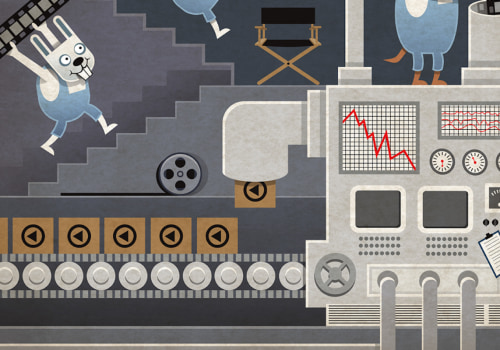The five stages of video production are strategy and development, pre-production, production and post-production. Each phase is designed to help plan and prepare for the next stages, ensuring that the process unfolds in the best possible way. Let's analyze each phase and go into detail about what they entail. You know that you need a video to attract your customers and followers, but it's not enough to think of an idea and start shooting.
Following a series of video production steps helps you control your budget, schedule, shooting needs, and more. Follow these production phases to get organized and achieve the best results. You wouldn't start a project for a client without first having a meeting to understand their needs and create an action plan, and neither should you record a video without a plan. The first step in the video production stages is to set your goals.
Before you set a budget, brainstorm ideas, and start creating storyboards, you need to determine what you want to achieve with your video. Next, set your budget and schedule. If you've already ventured into video advertising, you might think that you need hundreds of thousands of dollars to create a 30-second video. However, with new advances in video technology, you can expand your video budget.
You might not be able to create an eye-catching advertisement with celebrity cameos, but you can create high-quality videos that entertain your audience while effectively telling your story and reducing video production costs. Once you've narrowed down your ideas and chosen your favorite, set a budget range. This will help you when you begin to create a schedule, search for locations, search for talent, plan sets and other production items. With your idea in hand, you can start the next phase of production: pre-production.
In this step, you'll create your video production schedule, your storyboard, your script, and anything else you need to keep the production going once you've started shooting. Storyboards are an essential part of any video production. A storyboard is a visual graphic in which the key scenes of a video are shown. You don't have to be a star artist to make a storyboard.
You just need to draw well enough to communicate your shooting ideas to your videographers and graphic designers when you include animations. Write your script and use it to create a visual representation of the script. Put notes under each sketch to keep the production team on the same page. If you have specific ideas for cuts or animations, add them to your notes.
Phase 2 is also where you'll prepare everything you need for the production, such as your location, talent, accessories and decorations, and anything else you need before you start shooting. When you set your schedule, set deadlines to get everything you need, so you don't have to work hard on the day of shooting. If you have a detailed script and storyboard, phase 3 should go smoothly. This is the video production stage where you can actually record your video.
Submit your production schedule in advance so everyone knows when they need to be on set to create the main video. This phase of video production involves editing the video, mixing the sound, adding graphics or animations and preparing the video for distribution. In this phase, you'll cut your video, edit and mix voices, music and other sounds, add special effects, and improve video images to ensure that the video looks polished and professional before you market it. At this stage, you'll bring your storyboard to life and place additional material, graphics, and animations on top of your raw video images.
This is one of the most labor-intensive phases of video production, and many business owners outsource post-production to professionals with the goal of creating uninterrupted videos. If seeing the stages of video production explained still makes you hesitant to try video marketing, consider using QuickFrame to streamline your production schedule. Our video production platform uses machine learning to optimize every step of the process and provide you with the best video content for your needs. Video marketing is one of the most effective ways to reach your audience, but the cost and technical aspects of video production may have kept you away from this marketing tool.
Dividing the process into stages helps you keep your team organized and up to date, so you can maximize your budget. Once you know your goals, you can create videos that are realistic and implementable for your needs. If you're still not sure how to enter the world of video marketing, contact QuickFrame and find out how our simplified approach to the stages of video production can work for you. Pre-production planning is a less abstract and more specific form of planning than the ideation, strategy and development phase.
This is where a storyboard will be made to describe each individual scene, including the writing of the script. Pre-production planning should include all the assets that production needs from top to bottom. This includes equipment rental, talent, and quotations for all items that will need to be rented or purchased. The more detailed the planning, the less likely it is that the shoot will exceed budget or miss deadlines.
During pre-production, the shooting schedule will have been planned in the most efficient way. This shooting schedule will be followed as best as possible by the crew. At each shoot, the production team will install the equipment, complete the shoot and then disassemble it, and any problems that arise on set, such as a malfunction of the equipment, will have to be resolved on the fly. Due to time pressure, everyone on set will have a specific job and will be responsible for completing it as scheduled.
Social media platforms: mainly platforms based on social networks are an excellent place to share videos that have already been published on a video platform or to upload videos directly to them. Pre-production can also be considered as a general term for any and all video marketing and production needs, which simply must be realized before the video creation process actually begins. In pre-production, the planned content and the objectives that were defined in the strategy part of video production become practical. Article by Joe Forte, owner and producer of D-Mak Productions, a Scottsdale video production company specializing in the production of corporate, commercial, digital and branded multimedia content.
A more complex video can take several weeks to complete, especially if multiple locations and sets are desired. Before a camera operator touches “record” or any video editor clicks “export”, the real magic of cinema really happens. But what do these terms mean for a modern video producer or creator? And how do we actually define these steps, such as writing, filming and editing?. Defining tasks and knowing who is responsible for completing them helps ensure that everyone has a manageable workload and that the completion of their tasks fits the video production schedule.
.










